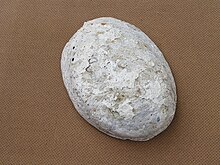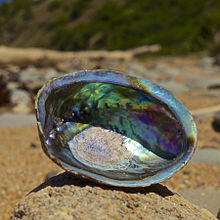Haliotis iris
| Haliotis iris | |
|---|---|

| |
| A shell of Haliotis iris | |

| |
| Ventral view of a shell of Haliotis iris | |
| Scientific classification | |
| Kingdom: | |
| Phylum: | |
| Class: | |
| (unranked): | clade Vetigastropoda
|
| Superfamily: | |
| Family: | |
| Genus: | |
| Species: | H. iris
|
| Binomial name | |
| Haliotis iris Gmelin, 1791
| |
Haliotis iris, common name paua or blackfoot paua, is a species of edible sea snail, a marine gastropod mollusk in the family Haliotidae, the abalones. It is endemic to New Zealand.[1]
Description
Paua belong to the molluscan genus Haliotis that is more commonly known as abalone. The name Haliotis derives from Greek and means sea ear, reflecting the ear like shape of the abalone shell. Three species of abalone occur naturally in New Zealand: blackfoot paua (Haliotis iris), yellowfoot paua (Haliotis australis), and whitefoot paua (Haliotis virginea).
Black foot paua is the largest abalone species found in New Zealand and is most commonly found in shallow cool waters at depths less than 6 m all around mainland New Zealand, Stewart Island, and the Chatham Islands. They often form large clusters in the sub-littoral zone on open, exposed coasts where drift seaweed accumulates and there is good water movement. Blackfoot paua grow to about 180 mm in shell width.
Human use
Haliotis iris are the only farmed species of paua found in New Zealand mainly because of their size compared to its smaller relatives - the "yellow foot paua" and the even smaller "virgin paua" - which are also commonly used for jewellery arts and carvings around New Zealand. Worldwide trade of natural pearls (also known as Haliotis Iris pearls or Paua pearls)
References
- ^ Oliver, A.P.H. (2004). Guide to Seashells of the World. Buffalo: Firefly Books. 18.
External links
